【C++要笑着学】从零开始实现日期类 | 体会代码的复用 | 提供完整代码
写在前面:
上一章我们讲解了运算符重载,本篇将手把手从零开始一步步实现一个Date类,将会对每个步骤进行详细的思考和解读。
Ⅰ. 实现日期类
0x00 引入
为了能够更好地讲解运算符重载的知识,我们将手把手、一步一步地实现 "日期类" ,
因为通过日期类去讲解运算符重载是比较合适的。
日期类的拷贝构造、赋值、析构我们都可以不用写,让编译器自己生成就行了。
0x00 设计构造函数
规范一点,我们声明与定义分离开来。
💬 Date.h
💬 Date.cpp
🚩 运行结果如下:
构造函数我们用了全缺省,这样我们不给值的时候也可以打印默认的值。
通过打印函数我们有可以把日期打印出来,这里可以加 const 修饰,
上一篇我们说过,加 const 是很好的,只要不改变都建议加上 const 。
比如这里的 Print 是可以加 const 的,
而构造函数这里修改了成员变量,是不能加 const 的。
现在我们现在来思考一个特殊的问题……
如果,我是说如果!我们输入的日期是一个非法的日期呢?
💬 比如:
🚩 运行结果如下:
如果有人输入了这种日期,还是能给他打印出来,
这合理吗?这不合理!
有人又觉得,谁会拿这种日期初始化啊,这种日期不是一眼就能看出来有问题嘛……
💬 说得好,那这些呢?
是不是没有那么容易一眼看出来了?这都涉及到闰年的问题了。
所以我们需要设计一个函数去判断,用户输入的日期到底合不合法。
💬 Date.h
因为每个月天数不统一,所以在写判断日期合法的算法前,
我们需要先设计一个可以获取一年中每个月对应天数的 GetMonthDay 函数。
如何设计呢?写12个 if else?
可以是可以,但是好像有点搓啊。
用 switch case 可能还好一点。我们这里可以写个简单的哈希来解决,
我们把每个月的天数放到一个数组里,为了方便还可以把下标为 0 的位置空出来,
这样我们就可以直接按照 "月份" 读出对应的 "日期" 了。
根据我们小时候背的口诀,依次把日期填到数组中就行了。
这里还要考虑到我们上面提到的闰年问题,闰年二月会多一天。
如果月份为 2,我们就进行判断,如果是闰年就让获取到的 day + 1 即可。
💬 Date.c
🔑 解读:
创建一个 day 去获取月份对应的天数,然后进行判断。
如果传入的月份是2月,就判断是否是闰年。
这里的一个小细节就是我们是先判断传入的月份2月的,
如果不是2月我们是压根没有必要进行闰年判断的,
根据 && 的特性,碰到假后面后不会判断了,所以我们先判断传入的月份是否是2月,
是2月 —— 为真,再继续判断是否是闰年。
如果是闰年,让天数+1,就完事了。
有了GetMonthDay 函数,就解决了每个月天数不统一的问题了。
💬 我们可以写判断部分了:
🚩 运行结果如下:
判断用户输入的日期是否合法的功能就写出来了,如果用户输入的日期不合法,
就把他铐起来! 我们就提示用户这是一个非法日期。
0x01 判断大于 operator>
比较两个日期的大小。
💬 Date.h
💬 Date.cpp
🔑 解读:
日期的判断很简单,我们只需要挨个对比就可以了,
结果返回布尔值,没什么好说的。
为了方便测试,我们再开一个 test.cpp 来放测试用例,方便后续测试我们的代码。
💬 test.cpp
🚩 运行结果如下:
0x02 日期加等天数 operator+=
合并一个日期似乎没什么意义,但是加天数的场景就很多了。
比如我们想让当前日期加100天:
加完后,d1 的日期就是加了100天之后的日期了,我们这里要实现的就是这个功能。
💬 Date.h
日期加天数没有难的,就是一个 "进位" 而已。
把进位搞定就可以了,在动手前我们可以先画个图来分析分析怎么个进法:
很明显,只需要判断加完日期后天数合不合法,
看它加完后的天数有没有超出这个月的天数,如果超过了就不合法。
这个我们刚才已经实现过 GetMonthDay 了,这里就直接拿来用就行了。
如果不合法,我们就进位。天满了往月进,月再满就往年进。
💬 Date.cpp
首先把天数都倒进 d1 里,之后检查一下天数是否溢出了。
如果溢出就进位,这里的逻辑部分通过我们刚才画的图可以很轻松地实现出来,
天满了就往月进位,月满了就往年进位。
最后返回 *this ,把我们加好的 d1 再递交回去就ok了。
因为出了作用域对象还在,我们可以使用引用返回减少拷贝,岂不美哉?
💬 test.c
🚩 运行结果如下:
0x03 日期加天数 operator+
还是和 += 一样,日期加日期没有什么意义,但是 "日期 + 天数" 还是用得到的。
所以我们重载 operator+ 为一个日期加天数的。
💬 Date.h
+= 是改变 "本体",但是 + 并不会,所以这里可以加个 const 修饰一下。
+ 和 += 很类似,也是通过 "判断" 就可以实现的,
因为我们刚才已经实现过 += 了,所以我们可以做一个巧妙地复用。
复用我们刚才实现的 += ,我们来看看是怎么操作的。
💬 Date.c
我们只需要做 "加" 的工作,把算好的日期返回回去就行了,
我们将 "本体" 复制一个 "替身" 来把结果返回去,利用拷贝构造复制出一个 ret 出来,
我们对这个 "替身" 进行加的操作,这样就不会改 "本体" 了
顺便提一下,因为它出了作用域会死翘翘,
所以我们 —— 不能用引用返回!不能用引用返回!不能用引用返回!
重点来了,这里巧妙地复用我们刚才已经实现好的 += ,就可以轻松搞定了:
如果觉得看起来不爽,我们甚至可以直接这么写:
就是这么浅显易懂,可读性真的是强到炸。
+= 之后 ret 的值就是加过 day 的值了,并且是赋到 ret 身上的,所以 ——
直接 重仓 return 回去,就大功告成了,我们来测试下代码。
💬 test.cpp
🚩 运行结果如下:
复用真的是一件很爽的事情,我们下面的讲解还会疯狂地复用的。
0x04 日期减等天数 operator -=
我们刚才实现了 operator+= ,现在我们来实现一下 -= 。
+= 进位,那 -= 自然就是借位。
日期如果不合法,往月去借,月不够了,就往年去借。
💬 Date.h
我们先把日期减一下,此时如果天数被减成负数了,那我们就需要进行借位操作。
💬 Date.cpp
如果减完后的天数小于等于 0,就进入循环,向月 "借位" ,
因为已经借出去了,所以把 月份 - 1 。还要考虑月份会不会借完的情况,
月份为 0 的时候就是没得借了,这种情况就向年借,
之后加上通过 GetMonthDay 获取当月对应的天数,就是所谓的 "借",
循环继续判断,直到天数大于0的时候停止,返回 *this 。
出了作用域 *this 还在,所以我们可以使用引用返回 Date& 。
💬 test.cpp
🚩 运行结果如下:
0x05 日期减天数 operator -
一样的,没什么好说的,我们复用一下 -= 就可以把 - 实现出来了。
💬 Date.h
直接复用就完事了,和 operator+ 思路一样。
💬 Date.cpp
为了顺便带大家体验测试代码的重要性,这里的测试部分我们单独拿出来举例。
0x06 体会测试代码的重要性
我们来好好测试一下刚才写的 operator- ,这里我们进行一个详细的测试,
测试减去的 day 跨月,跨年甚至跨闰年的情况,这样哪里出问题我们可以一目了然。
💬 test.cpp
🚩 运行结果如下:
Tips:我们在验证的时候可以再网上找这种在线的日期推算器,来验证一下我们写的对不对。
刚才我们正常测试,确实没什么问题,我们来测试个极端的情况,
❓ 如果我们给的是 d1 - -100 呢?
🚩 运行结果如下:
我们这里代码是复用 operator-= 的,所以我们得去看看 operator-=
我们发现,在设计 operator-= 的时候是 <= 0 才算非法的,所以这种情况就没考虑到。
我们可以这么设计,在减天数之前对 day 进行一个特判,
因为你减负的100就相当于加正的100,就变成加了,
⚡ Date.cpp
这样就正常了。
我们再把 operator+= 处理一下:
⚡ Date.cpp
所以多写几个测试用例,来测一测各种情况,是非常有必要的。
0x07 日期加加 operator++
📚 日期++ 分为 "前置++" 和 "后置++"
因为都是 operator++ ,为了能让编译器直到我们实现的到底是 前置++ 还是 后置++,
这里就到用到一个叫做 "参数占位" 的东西 ——,即:
后置++ 带 " int " ,构成函数重载。
实现前置++ :
💬 Date.h
因为 前置++ 返回的是加加之后的值,所以我们使用引用返回。
加不加引用就取决于它出了作用域在不在。
💬 Date.cpp
这里我们直接复用 +=,加加以后的值就是 *this ,我们返回一下 *this 就行。
实现后置++ :
💬 Date.h
因为后置++返回的是加加之前的值,所以我们不用引用返回。
💬 Date.cpp
我们在加加之前先拷贝构造一个 "替身" 出来,"本体" 加加后,
把替身 ret 返回回去,就实现了返回加加之前的值。
这里要拷贝构造两次,所以我们推荐以后自定义类型++,使用前置++ 。
💬 test.cpp
🐞 监测结果如下:
0x08 日期减减 operator--
📚 日期-- 分为 "前置--" 和 "后置--"
和 operator++ 一样,operator-- 为了能够区分前置和后置,也要用 int 参数占位
后置-- 带 " int " ,构成函数重载。
实现前置-- :
💬 Date.h
对应的, 前置-- 返回的是减减之后的值,所以我们使用引用返回。
💬 Date.cpp
这里我们直接复用 -=,减减以后的值就是 *this ,然后返回 *this 。
实现后置-- :
💬 Date.h
因为 后置-- 返回的是减减之前的值,所以我们不用引用返回。
💬 Date.cpp
我们在减减之前先拷贝构造一个 "替身" ,待本体加加后,
把替身 ret 返回回去,就实现了返回减减之前的值。
0x09 判断日期是否相同 operator==
💬 Date.h
💬 Date.cpp
只有年月日都相等才是 true,否则就是 false。
0x0A 体会复用的威力
📚 引入:
比如我们要实现 operator<,因为大于我们已经实现过了,
我们现在来写 <,可以直接把大于改成小于:
…… 既然都能这样了,那为什么不用用神奇的复用呢?
我们已经把 operator> 和 == 实现了,剩下的这些我们都可以复用解决。
技巧:对于类的比较,实现一个 > 和 == 其它直接复用就完事了。
(当然,实现一个 < 和 == 也行,随你便)
这个技巧不仅仅针对于日期类的比较,所有类要实现比较,都可以用这种方式,
除非它们不互斥( >= 取反是 < ,这就是互斥 )。
0x0B 判断大于等于 operator>=
💬 Date.h
💬 Date.cpp
直接复用解决就完事了,这波真是秦始皇被雷劈,嬴麻了。
0x0C 判断小于 operator<
💬 Date.h
小于,不就是既不大于也不等于嘛。
所以我们直接复用 operator>= 就完事了。
💬 Date.cpp
这里取反就可以了,如果 d1 >= d2 为真,取反后 ! 则返回假。反之返回真。
0x0D 判断小于等于 operator<=
💬 Date.h
💬 Date.cpp
小于等于,就是 > 取反,没什么好说的。
这里你还可以用 < || == ,也可以的。
0x0E 判断日期是否不相等 operator!=
💬 Date.h
不等于和等于逻辑是相反的,直接反 ! 就完事了。
💬 Date.cpp
0x0F 日期减日期 operator-
我们刚才实现的 operator- 是日期减天数的:
❓ 如果我们想要计算一下距离暑假还有多少天呢?
那我们就需要写一个日期减日期版本的 operater-
💬 Date.h
我们现在想的是日期减日期,我们可以让小的天数去加大的天数。
💬 Date.cpp
我们可以用立 flag 法。
我们先立个flag 假设 —— 第一个日期大,第二个日期小。
flag 为 1 表示第一个大第二个小,flag 为 -1 表示第一个小第二个大。
分别创建 max 和 min 表示第一个日期(d1)和第二个日期(d2)。
然后走一遍判断,核实一下立的 flag 对不对,不对的话就纠正一下。
之后我们用计数器的方式来实现就可以了。
💬 test.cpp
0x10 打印今天是周几 PrintWeekDay
❓ 打印今天是周几什么什么意思?
" 打印今天是周几,就是打印今天是星期几。" —— 节选自《 节选自 <节选> 》
💬 Date.h
💬 Date.cpp
我们拿 1900年1月1号 作为起始点,两个日期相减得到的结果,
%7 作为下标去访问 week 数组里我们已经准备好的周几,打印出来就可以了。
⚡ 这个 start 反正我们就在这用一下而已,后面也用不着了,这里就可以使用匿名对象:
💬 test.cpp
大功告成!!!
Ⅱ. 完整代码
0x00 Date.h
0x01 Date.cpp
0x02 test.cpp
参考资料:
Microsoft. MSDN(Microsoft Developer Network)[EB/OL]. []. .
百度百科[EB/OL]. []. https://baike.baidu.com/.
比特科技. C++[EB/OL]. 2021[2021.8.31]. .
- 点赞
- 收藏
- 关注作者













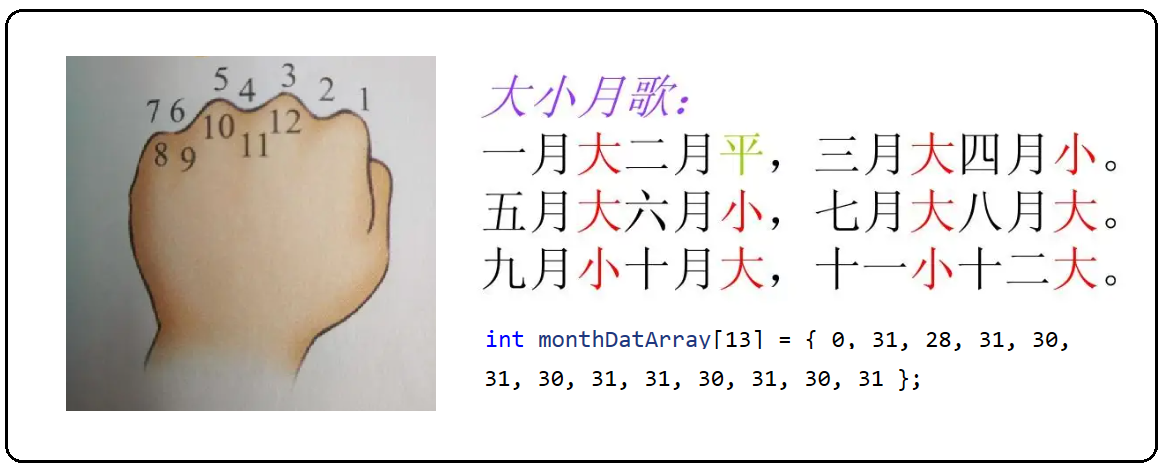
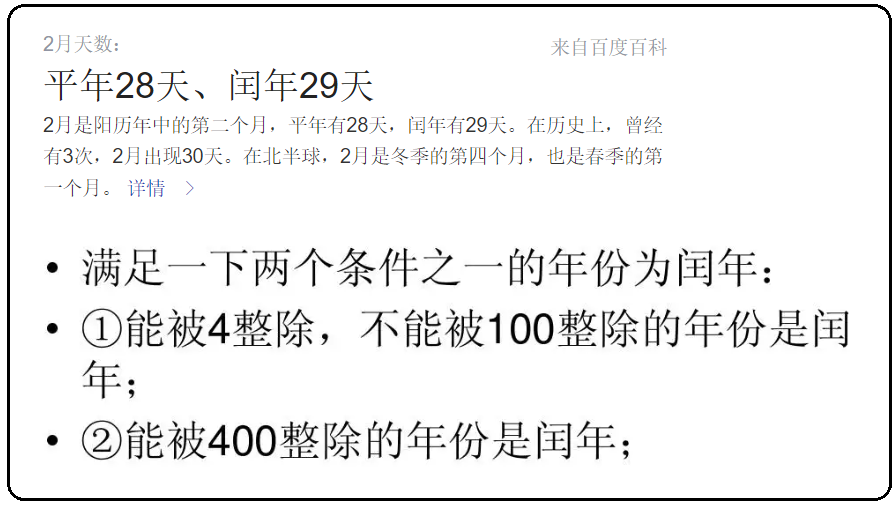










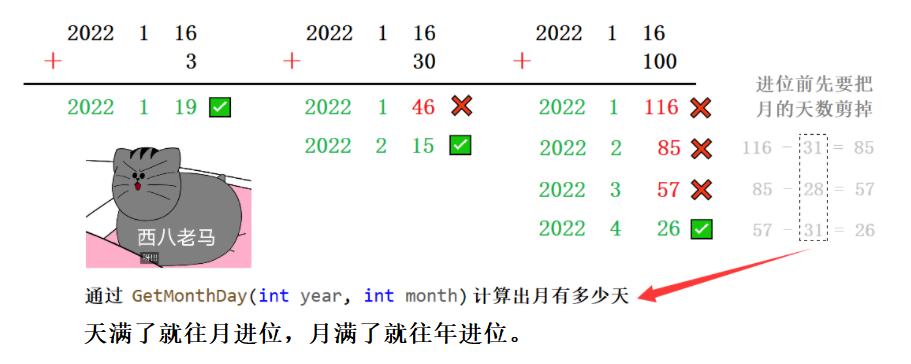



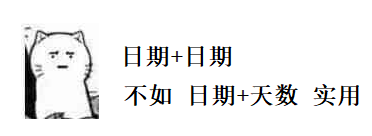
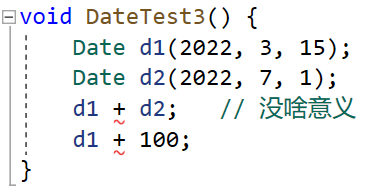












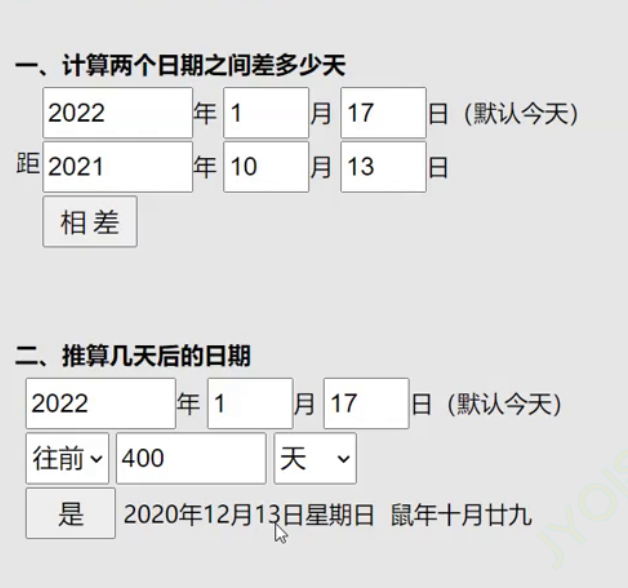
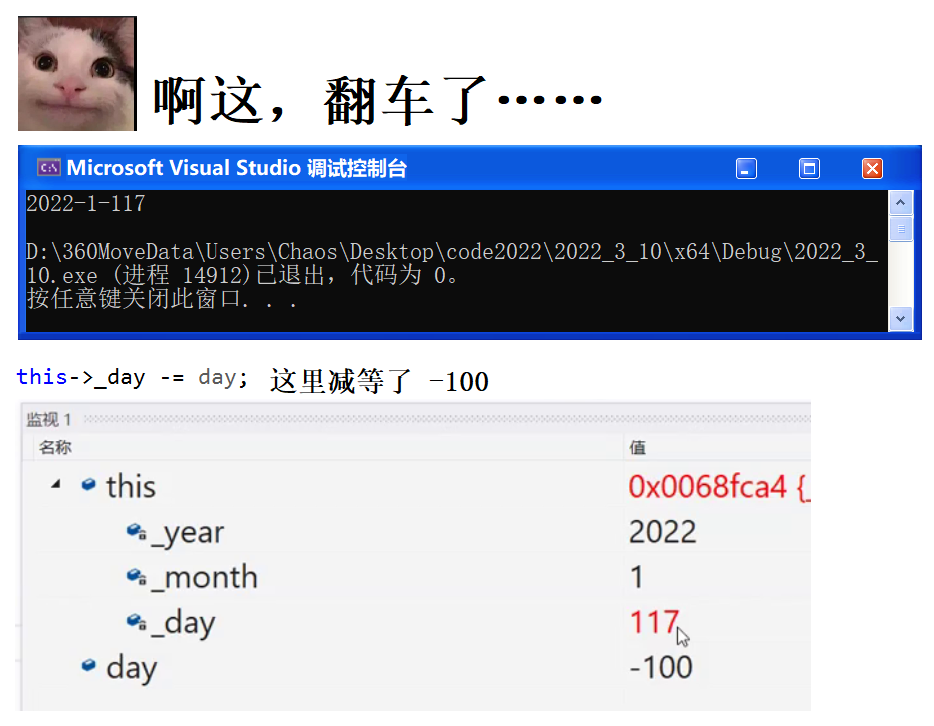





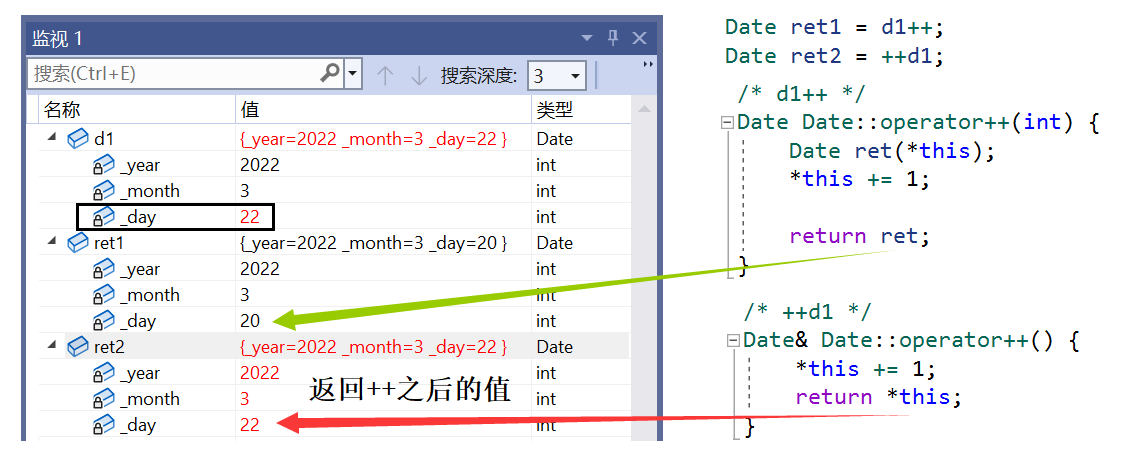




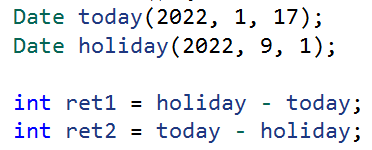



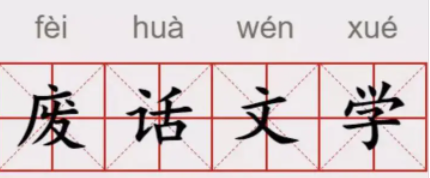



评论(0)